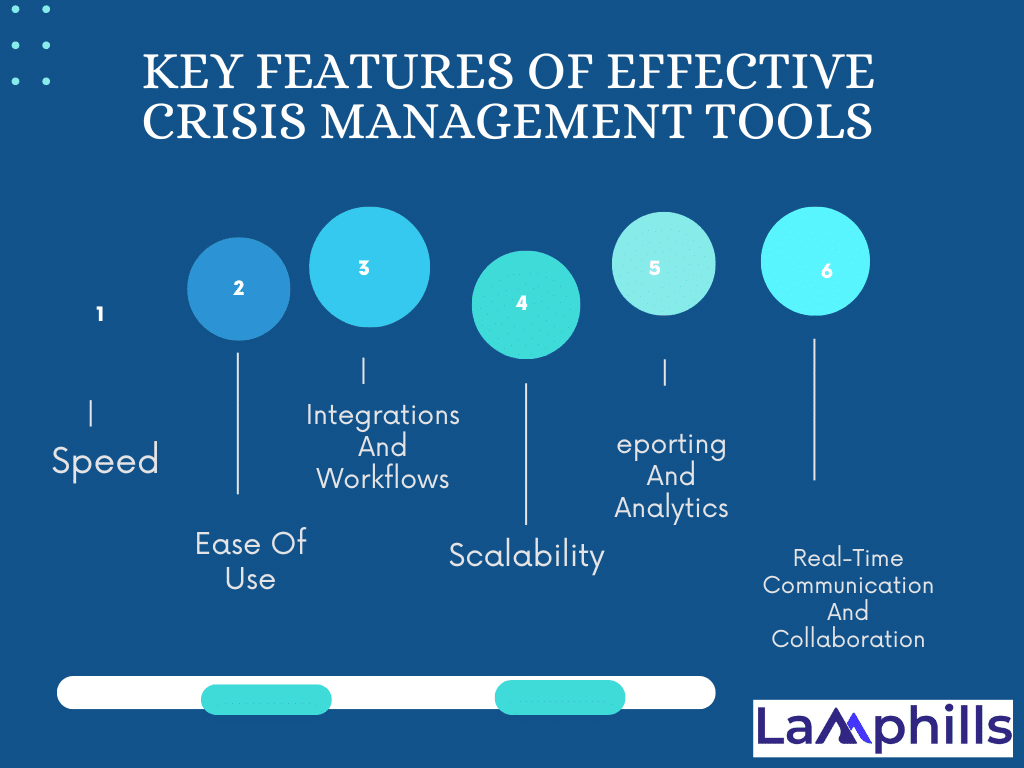Crisis management—those two phrases frequently spring up feelings of urgency, if not terror. I understand the sensation firsthand since I’ve watched businesses around me struggle to keep up with unanticipated disruptions. Whether it’s a cyberattack, a natural calamity, or even an economic crisis, uncertainty appears to appear round every corner. As a content writer, I’ve witnessed how the appropriate tools can make or break an organization’s capacity to withstand a storm. In this article, I’ll look at the best crisis management tools for protecting your business when things get tough. These tools are the backbone of firms that want to grow in the face of adversity, rather than simply survive.
Key Takeaways
- Crisis management is all about being ready before disaster strikes. Having the right tools in place ensures your business can swiftly navigate through crises, protecting both its reputation and operations.
- Tools that enable quick decision-making and seamless communication across teams—especially during a crisis—are essential. They help keep everyone aligned, even in remote settings, avoiding confusion and delays.
- Using tools to monitor online news and social media gives businesses a heads-up on potential crises before they blow up. Tools like CisionOne and Talkwalker allow you to track public sentiment, making early intervention possible.
- As a company grows, its crisis management tools should scale with it. Tools that adapt to increased data loads, users, and complex workflows can make managing crises more efficient at any business size.
What is Crisis Management?

A few years ago, I was working with a small software business that was caught in the crossfire of a massive data breach. For several days, their phones rang nonstop with concerned customers, as the company tried to deal with the situation. While they were able to recover, it was a difficult lesson in how unprepared they were for such a disaster.
This circumstance is far too common. When a crisis strikes, organizations can risk anything from operational interruptions to long-term reputational damage. Businesses that do not have an effective crisis management strategy risk losing not only money but also the trust of their clients and stakeholders.
Crisis management is a pre-planned technique that assists businesses in dealing with a sudden and severe unfavorable situation. It encompasses strategies for brand protection, reputation management, and risk management. It is all about being prepared so that when a crisis occurs, you are ready to resolve it. Now, the key to this preparedness is the judicious use of crisis management technologies, which assist organizations in monitoring, managing, and mitigating the effects of big events.
What Are Crisis Management Tools?
When your company or brand is experiencing challenges, a crisis management tool will not instantly resolve the situation. However, effective crisis management tools can assist prevent difficulties from occurring, safeguard you during a crisis, and educate you on best practices for the next time.
Crisis management tools help organizations track brand sentiment around employee scandals. These management tools have evolved into key components of an organization’s resilience plan. They are designed to assist everyone, from lone employees to huge crisis management teams, in gathering real-time information, providing insights for decision-making, and fostering a coordinated response across all levels of an operation.
These tools include elements like online news and social media monitoring, which are vital for staying on top of the issue as it unfolds, as well as reporting capabilities that make complex data understandable and shareable among team members.
In today’s business context, effective crisis communication is not an option, but rather a requirement. These tools, by integrating with existing workflows and allowing for a cross-functional approach, break down divisions and create unified frontlines during crisis situations. They are crucial in maintaining brand reputation and dealing with unsatisfied customers.
Key Features of Effective Crisis Management Tools

While many communication solutions provide bells and whistles, such as AI writers and Canva integrations, these are ineffective in a crisis. The best crisis management software prioritizes a few things.
#1. Speed
When I say speed, I am not referring to load time. A speedy, bug-free interface is essential for crisis tools. A crisis management software should include functionality that allows you to reply to customers quickly. Consider this:
So, look for customizable notifications that may be sent to your phone or email so you know about a negative social media mention or news report the moment it happens. A high-quality mobile app is an added plus, allowing you to answer from anywhere.
#2. Ease Of Use
The best crisis management tools strike a mix between complex capabilities and ease of use for routine tasks, such as social network posting. For large businesses with hundreds of mentions, advanced search and AI insights can be useful. However, without a simple interface, you risk complicating your crisis response with an error or missed notification.
According to Edelman, online news and social media monitoring are critical for executive decision-making during a crisis. It is critical that the reporting be visual, simple to understand, and easy to distribute.
#3. Integrations And Workflows
Because crisis management transcends divisions, its tools must be created for complicated teams. I once handled junior associates who created social media content for a national brand. We used a social media tool that let me preview, approve, and edit my younger team members’ posts before they went live. You may require a similar arrangement for compliance or client approvals.
Workflows and integrations are also essential for integrating with customer service. The best crisis management platforms allow you to establish cases or tickets, assign action items to team members based on messaging, and provide customers with context. These break down silos and let teams work together more quickly.
#4. Scalability
As your organization grows, your crisis management tools should be able to scale accordingly. Scalable tools can handle increased data and user loads without compromising performance.
#5. Reporting And Analytics
In times of crisis, data is your friend. Crisis management systems provide complete reporting and analytics capabilities. They give you insights into how effective your communication was, allowing you to identify and change areas for growth. Furthermore, historical data analysis enables you to discover potential risks and plan for future issues.
#6: Real-Time Communication And Collaboration
By following this Real-Time Crisis Response Action Plan, you’ll be prepared to manage crises effectively, ensuring your business remains strong even in uncertain times.
When a crisis strikes, rapid decision-making is critical. Tools that enable real-time communication and collaboration ensure that everyone is on the same page, regardless of where they are. Think back to when remote employment was becoming the norm. A friend of mine, a manager at a retail company, told me of a sudden power outage that devastated their supply chain. The lack of a real-time communication platform meant that their team was scattered and in disarray.
The Crisis Management Tools I Tested
Let’s get to the heart of this topic—what are the best tools out there? I’ve done some digging and personal testing, and here’s a list of crisis management tools that can help safeguard your business:
#1. HubSpot
Centrality is essential during a crisis. If your marketing and customer care teams are already utilizing the same platforms, it will be simple to share information with all stakeholders. HubSpot allows you to post on social media, monitor the internet talk about any business, and respond to customers all in one spot. HubSpot’s Marketing Hub unifies interactions and audiences across Facebook, Instagram, LinkedIn, and X, making it simple to respond from a single email.
With Service Hub, I can even contact affected customers and generate and resolve problems. I enjoy how easy HubSpot is to use and how it mixes social media management, CRM, and customer support. If you already have a customer and media list, you’ll be ready to distribute key information at a moment’s notice.
What it lacks: While I can’t send a newswire release, I can use the CRM function to build media lists and manage distributions to them.
#2. CisionOne
CisionOne’s crisis toolkit helps PR professionals and marketing teams implement a rapid approach when a crisis occurs. CisionOne keeps customers up to date on the latest news by monitoring millions of articles, social posts, videos, and broadcasts. If a brand’s reputation begins to deteriorate, you may identify it promptly and address the issue. While developing your crisis strategy, use the toolkit for help, and use CisionOne’s sophisticated features to monitor your industry. Cision was my go-to tool for managing media relations on daily daily basis. The software consists of several components.
- The first is a robust media database where you can filter by location, media type, role, or beat.
- The second is a distribution system where you can send customized pitches or press releases to the media by email.
- Third, you can monitor and analyze your news coverage across online, print, and broadcast.
- Finally, you can distribute multimedia press releases with PRWeb wire releases.
I love Cision’s top-of-the-line media database and real-time media monitoring. While the platform’s hard to beat for media monitoring and management, it’s not built for direct customer interactions.
#3. Business Wire
For more than a decade, public relations professionals have declared the press release dead, but there are still a few scenarios where it is still beneficial, one of which is a crisis. I initially came across Business Wire while working for a public firm that required a wire provider to meet SEC regulations. Business Wire serves both private and public companies and is known for its reliability.
To move it into the twenty-first century, Business Wire partnered with Muck Rack in 2020, a journalist-first media directory that allows you to identify and pitch media outlets around the country.
What it lacks: While Muck Rack is integrated with Business Wire, the two services remain separate platforms, creating more work to go between them. With this powerful duo, you still lack a social media management component.
#4. Hootsuite
Anyone active on social media for the past decade has utilized this friendly bird at some point. No, not the blue one; I’m talking about Hootsuite. Hootsuite allows businesses to consolidate all of their social listening, posting, and messaging in one place. It’s simple to use and indispensable at times of distress.
It also supports configurable approval protocols, allowing you to incorporate team checks and balances into your crisis response. Some of the most useful features are only available with the corporate account, such as Zendesk customer service integration and the Chatbot capability.
The platform’s reporting and social listening aren’t as robust as other programs I tested, limiting your reporting to brand mentions. Hootsuite integrates with TikTok and YouTube, adding appeal for brands using video platforms.
#4. Sprout Social
Sprout Social, like other social platforms, is supposed to serve as a centralized inbox and social media publishing tool. It has an appealing design and allows you to find what you need when you need it.
When I evaluated Sprout Social, I discovered a few additional characteristics that make it very enticing during a crisis. The program use artificial intelligence to elevate messages containing unfavorable sentiment and notify you if there is a rise. I can design workflows, label communications, and assign cases and requests. The social listening feature crawls not only social media but also news websites, Reddit, and YouTube. Help Desk connectors with HubSpot, Salesforce, Zendesk, and other services enable you to interface with customer service.
What it lacks: Sprout Social doesn’t have any media relations capabilities outside of social media. I’d still need to go elsewhere to send a press release.
#5. Meltwater
Meltwater is a useful tool for managing media relationships and identifying unfavorable breaking news in real time. The collection of tools allows you to create bespoke reports to monitor and evaluate both news coverage and social discussion. You can also contact journalists and influencers, issue a wire release using GlobeNewswire, and connect your data for enhanced analytics.
Meltwater provides powerful tools for monitoring and controlling media coverage, and it’s the only platform that allows me to handle everything from social media to press release delivery. However, the platform is not always straightforward, and it took me some time to figure out how to put up various reports. Meltwater lacks a customer service integration., but outside of that, it can do everything else I need in a crisis.
#6. X Pro
X Pro, formerly known as TweetDeck, is an excellent crisis management tool for monitoring your brand and managing a social media crisis. It’s basic yet effective. However, it is only accessible to X Premium subscribers.
Create a special column in X Pro to keep track of your brand references. In addition, you can build a search keyword to view all of your replies and tweets. This allows you to see who you’ve reacted to and how quickly – which is useful for reviewing your crises strategy and reactions after they’ve been addressed.
Monitor interactions, such as when someone mentions your brand, shares or quotes a post, or likes something you’ve done on your account, as well as when someone follows you or adds you to one of their lists.
#7. Slack
The methods presented in this guide are ideal for social listening and responding quickly to social media challenges. However, addressing difficulties will require more than simply monitoring tools. You’ll also need a quick, easy, and dependable means to notify your social media and marketing teams of any concerns that arise.
Slack is a cloud-based suite of crisis communication tools for team collaboration that keeps everyone connected at all times. It’s a quick and easy way to privately communicate with your entire team, individual members, or groups dedicated to certain tasks.
Slack promotes teamwork and workflow, and it allows you to share information need, as well as get in touch with the right people as quickly as possible. The best part? Slack is a free tool that anyone can download and use.
#8. MailChimp
While Slack allows you to interact with your team, you must also keep open lines of contact with your current customers. MailChimp is the solution. MailChimp is a great email marketing software that lets you create and target professional-looking email campaigns. It comes in both free and paid versions and can work wonders for your social media crisis management.
For example, if your business is involved in a negative social media issue, you can mitigate the harm by launching an email marketing campaign to calm your clients’ concerns. MailChimp allows you to develop your own templates, save time by using pre-designed templates, and create an email marketing campaign that is tailored to your needs.
#9. Mailjet
Mailjet is another excellent email crisis management tool that enables fast-moving businesses to maintain continuous communication with their clients. It includes hundreds of beautifully designed, unique templates for your campaigns, as well as a plethora of tools for analyzing and segmenting the right information to the right customers.
Mailjet gives you the ability to modify your templates and track your transactional email in real time, highlighting what’s important. Compare your campaigns and create customized campaigns for each customer. It’s an all-in-one email marketing campaign service that will keep you and your consumers connected in a simple and efficient manner.
#10. Talkwalker
Talkwalker provides powerful analytics for social media and online mentions, helping brands protect their reputation during crises. With real-time alerts and sentiment analysis, it equips organizations with the insights needed to manage their public image effectively.
Pros
- Comprehensive analytics for brand monitoring.
- Real-time alerts for quick responses.
- Strong sentiment analysis capabilities.
Cons
- Pricing can be high for small organizations.
- Complex interfaces may require training.
Key Features
- Real-time alerts for brand mentions.
- Sentiment analysis for understanding public perception.
- Image and video analytics for comprehensive monitoring.
What is the average cost of crisis management tools in 2024?
Pricing varies widely based on features and organization size, with options ranging from free plans to custom quotes for enterprise solutions.
Are there free crisis management tools available?
Yes, several tools like HubSpot and Buffer offer free versions that can be beneficial for small organizations looking to manage crises effectively.
Conclusion
In today’s unpredictable environment, any organization, big or small, must have a robust crisis management strategy in place. The tools I’ve discussed in this article are among the best in the industry, each with unique features that can assist protect your operations when the unexpected happens.
They are critical for guaranteeing your team’s ability to communicate in real-time, record issues, and identify hazards before they escalate. So, take the time to assess your company’s needs, test the appropriate solutions, and include these tools in your long-term resilience strategy. Don’t wait until a disaster strikes—prepare now. Your business will thank you later.






